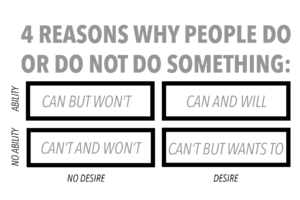
So far in our series on failure, we have discussed the inevitability of failure, how it helps us grow, and celebrating it as a symptom of innovation. But all of that has been from the assumption that the failure we’re talking about is a certain kind of failure: one that comes from genuine effort that did not turn out the way we wished it would.
Today I want to look at failure through the perspective of the Four Squares and see what kind of failure can come from acting through each of these mindsets.
The Four Squares is a mental model that helps us understand the intersection of desire and ability.

Can and Will
The Can and Will Square is the one we wish we could be in all of the time. It is where we have both the desire and ability to complete the task at hand.
This is the square that innovation comes from and failure in this square usually comes from trying to do something in a new way.
However, in this place where we have both desire and ability, it can be easy to bite off more than you can chew. Overloading yourself because you think you can do it all could also lead to failure. In this case, this failure would provide clarity of how much you will be able to handle at once in the future.
Can’t and Will
If you are in the Can’t and Will Square, it means that you want to complete a project but don’t yet have the skills necessary to do so.
Failure is common in this square. When you are learning something for the first time, there are bound to be mistakes. Failure in this square should be seen as a natural part of the learning process to be taken in stride and grown from.
Can and Won’t
This square is one of the hardest to get out of because it’s the place where you have the ability to complete a task but not the desire to do so. There’s always things you can learn if you want to, like in the Can’t and Will Square, but it’s difficult to manufacture desire.
Failure in this square comes from an unwillingness to try in the first place: the failure to start. Pushing off responsibility and tasks that you are assigned to only prolongs the problem though. They will not go away by procrastinating on them.
Can’t and Won’t
The final square is Can’t and Won’t. It is unlikely for failure to occur here because you will likely not be responsible for tasks that you neither have the desire or ability to do. But, if you are, then failure can serve as a helpful clarifying tool to realize that you are not fit for this role or task.
Failure is a fact of life. Most of the time, it is a sign that you are trying hard at something but made a mistake due to lack of knowledge or misstepped because you’re pushing into new territory.
Occasionally though, you can fail by shirking responsibility and pushing tasks off, which is an intentional failure that could have been prevented.
Our desire and ability to complete a task directly affects how we will approach it, which in turn impacts what kind of failure we might experience. But in all these cases, we should aim to use failure as a tool to help us gain clarity on how to move forward.
Gracie McBride is the Content and Systems Management Coordinator for The Crossroad.




